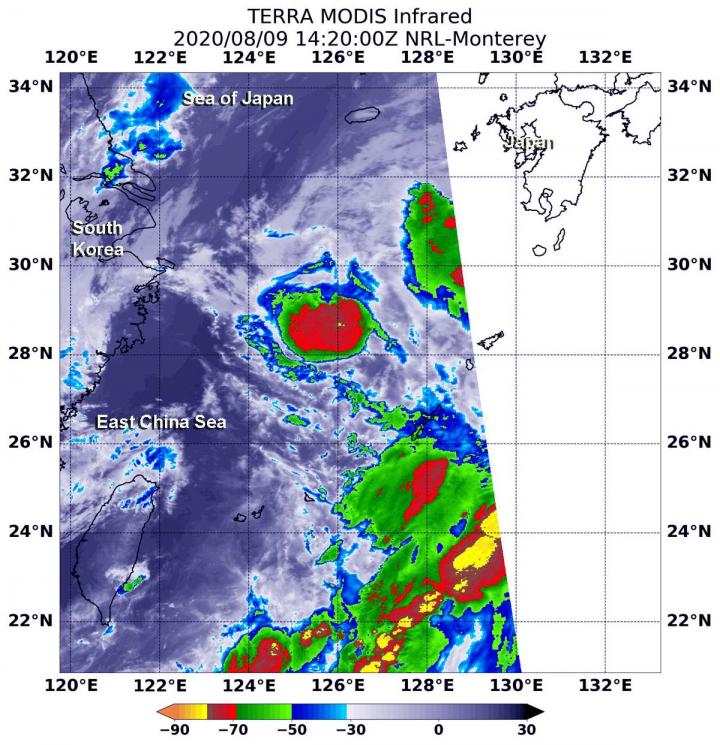
Credit: Credit: NASA/NRL
Tropical Storm Jangmi was exiting the East China Sea and moving toward the Sea of Japan when NASA’s Aqua satellite measured the strength of the system.
Jangmi formed as a depression on Aug. 8. At 5 a.m. EDT (0900 UTC), Tropical Depression 05W formed about 377 miles northeast of Manila, Philippines. Locally in the Philippines, the depression was known as Enteng. By 5 a.m. EDT (0900 UTC) on Aug. 9, the depression strengthened into a tropical storm.
On Aug. 9 at 10:20 a.m. EDT (1420 UTC) infrared data from the Moderate Resolution Imaging Spectroradiometer or MODIS instrument that flies aboard NASA’s Aqua satellite provided a look at cloud top temperatures in Tropical Storm Jangmi as it was about to move out of the East China Sea. Strongest thunderstorms that reach high into the atmosphere have the coldest cloud top temperatures.
MODIS found the most powerful thunderstorms were around the center of circulation, where temperatures were as cold as or colder than minus 70 degrees Fahrenheit (minus 56.6 Celsius). Cloud top temperatures that cold indicate strong storms with the potential to generate heavy rainfall.
On Aug. 10, the Joint Typhoon Warning Center noted that animated multispectral satellite imagery showed a partially exposed low-level circulation center with building strong thunderstorms in the northwestern quadrant of the storm.
On Monday, August 10, 2020 at 5 a.m. EDT (0900 UTC), the Joint Typhoon Warning Center (JTWC) noted that Tropical storm Jangmi was located near latitude 34.2 degrees north and longitude 128.7 degrees east, approximately 48 nautical miles south of Chinhae, South Korea. Jangmi was moving at 23 knots (26 mph/43 kph) and had maximum sustained winds of 35 knots gusting to 45 knots (52 mph/ 83 kph).
Jangmi is moving northeast past South Korea and is forecast to move into the Sea of Japan where it is forecast to merge with an approaching mid-latitude elongated area of low pressure (trough) and then become extra-tropical.
Tropical cyclones/hurricanes are the most powerful weather events on Earth. NASA’s expertise in space and scientific exploration contributes to essential services provided to the American people by other federal agencies, such as hurricane weather forecasting.
By Rob Gutro
NASA’s Goddard Space Flight Center
###
Media Contact
Rob Gutro
[email protected]
Original Source
https:/




